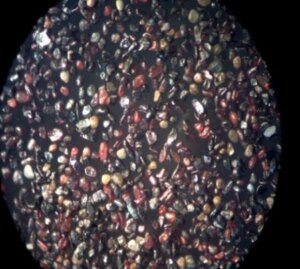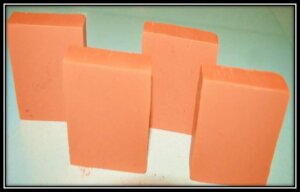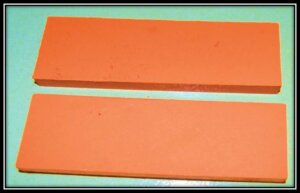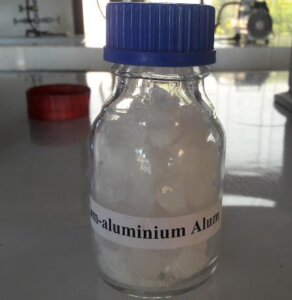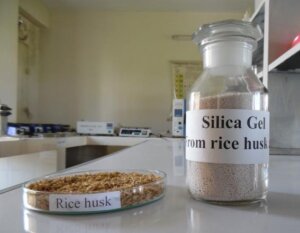List of All Patent Product Invented by BCSIR Geologist and Mineralogist in Bangladesh
ইনস্টিটিউট অব মাইনিং, মিনারেলজি ও মেটালার্জি (আইএমএমএম)
- An environmentally sustainable method of preparation of feedstock for products of aluminum from used beverage cans
| Name of the Unit | Institute of Mining, Mineralogy and Metallurgy (IMMM) |
| Area | metallurgy, environmental engineering |
| Uses | recycle of aluminum |
| Salient Features | some gentle pre-treatment makes used beverage cans ready for melting and casting |
| Scale of Development | The process is standardized at bench scale |
| Major Raw Materials | waste beverage cans |
| Major Plant Equipments/Machinery | Melting furnace |
| Details of specific application | The process results in aluminum metal ingots in pure state ready for use |
| Status of Development | The product has been examined and is found ready for industrialization |
| Ecological/Environmental Impact (if any, specify briefly) | on account of the recycling involved in the process, it is highly desirable environmentally |
| Patenting details | Patent filed |
| Commercialization Status | Ready for commercialization |
| Techno-Economics | Available on demand |
| Key words | aluminum, recycling, beverage cans |
- A process for the production of lead (Pb) free tin (Sn) based solder for electronic applications
| Name of the Unit | Institute of Mining, Mineralogy and Metallurgy (IMMM) |
| Area | Metallurgy, Electronics, Environment |
| Uses | Electronics, Repairing, Plumbing, Jewelry |
| Salient Features | Environment friendly, Pb-free |
| Scale of Development | The process is standardized at bench scale |
| Major Raw Materials | Zinc, Copper, Tin, Aluminum, Antimony and some fluxes. |
| Major Plant Equipments/Machinery | Melting Furnace, Rolling Mill |
| Details of specific application | Solder alloy is mainly used in electronics to join the components in printed circuit boards. In addition, it has a traditional application in plumbing to join pipes. |
| Status of Development | The product has been examined and is found ready for industrialization |
| Ecological/Environmental Impact (if any, specify briefly) | This very process is based on the theme of replacing toxic and health hazardous Pb-containing solders. The wide applications of this type of Pb- free solder will certainly help protect environment and human health and be compatible with the international regulations such as Restriction of Hazardous Substances Directive (ROHS) and European Union Waste Electrical and Electronic Equipment Directive (WEEE). |
| Patenting details | Patent will be filed soon |
| Commercialization Status | Ready for commercialization |
| Techno-Economics | Available on demand |
| Key words | Solder, Pb-free, Electronics, Toxicity |
- Preparation of Gemstones/Precious Stone from different rocks and minerals
| Name of the unit | Institute of Mining, Mineralogy & Metallurgy, BCSIR,
Joypurhat. |
| Area | Gemology |
| Uses | Jewelry or other adornments |
| Salient Feature | Natural real gemstone/precious stone |
| Scale of Development | The process is standardized at bench scale |
| Major raw Materials | Colorful granites, pegmatites, smoky quartz, milky quartz
etc.) of Maddhapara Granite Mining Co. Ltd and as well as
with some imported minerals like Amethyst, Lapis Lazuli
etc of India and Afghanistan. |
| Major Plant equipment | Sawing Machine, Feceting machine, Polishing machine |
| Estimated cost | 18,86,026.00 Tk. |
| Unit Cost | 78 taka/Carat |
| Commercialization status | Ready for Commercialization |
| Techno-Economics | Feasible (Pay back period 2Years), Different varieties of
gemstone have different price ranges and huge
demand throughout the world for its natural beauty. |
| Ecological/Environmental
impact |
This process is environmental friendly; all consumables
used in this process are nontoxic. |
| Socio-economic impact | By leasing developed process, polishing and cutting
oriented industries will be developed in our country
and large number of people will be employed. |
- RECOVERY OF RUTILE MINERAL FROM ARC ELECTRODE WAST
| Unit | Institute of Mining, Mineralogy & Metallurgy |
| Area | Industrial Mineral |
| Uses | The recovered rutile minerals will be used for making new arc electrodes. |
| Salient Features | a) Separation of Rutile minerals from arc electrode waste which is previously treated as trash.
b) Rutile minerals will be recovered and the recovered rutile minerals will be used for making new arc electrodes reduce production cost. c) New plant/factory will be established to recover the rutile minerals. d) In fact, about 100% of whole Rutile content of electrode arc waste will be recoverable. e) A new thought based on rutile mineral recovery from arc electrode waste industry will be developed in our country. The processed mineral will be used by Linde Bangladesh and as well as to other industries. Therefore employment opportunity will be created in our country as well as savings and earning foreign currencies. |
| Establishment Cost | TK. 1, 88, 32,500.00 |
| Scale of Development | The process is standarised at bench scale |
| Major Raw Materials | ARC ELECTRODE WASTE |
| Major Plant Equipment/Machinery | Magnetic separator, Electrstatic separator |
| Details of Specific Application | The process is used for rutile recovery from arc electrode waste |
| Status of Development | Ready for commercialization |
| Ecological/Environmental Impact (if any, specify briefly) | The process is physical separation method, so it is environmental friendly |
| Patenting Details | Patent will be filed |
| Commercialization Status | Ready for commercialization |
| Techno-Economics | Available on demand |
| Keywords | Rutile, Arc Electrode Waste |
- DEVELOPMENT OF A COST-EFFECTIVE AND LOW-TEMPERATURE METHOD TO PRODUCE CERAMIC TILES FROM SITAKUNDA SHALE (CLAY)
| Unit Name | Mineralogy Division, Institute of Mining, Mineralogy and Metallurgy, Joypurhat |
| Area | Engineering Geology |
| Uses | The developed tiles will be used for roof tiles, floor tiles, facing etc. |
| Salient Features | a) Natural red color ceramic tiles
b) New source of raw material for ceramic industry. c) New ceramic industries will be established. d) Various physical and chemical properties of clay samples are preferred for various construction purposes e) Developed ceramic tiles with low water absorption and high compressive strength using low temperature method. f) Cost effective and employment opportunity will be created in our country as well as savings and earn foreign currencies. |
| Scale of Development | The process is standarised at bench scale |
| Major Raw Materials | Red clay (Shale) of Sitakunda Upazilla, Chittagong District |
| Major Plant Equipment/Machinery | Mixer machine, Tunnel Kiln, Press Machine |
| Details of Specific Application | Utilization of red clay (Shale) of Chittagong area to develop ceramic tiles |
| Status of Development | Ready for commercialization |
| Ecological/Environmental Impact (if any, specify briefly) | The process is cost effective and low temperature method .so it is environmentally friendly |
| Patenting Details | Not filing |
| Commercialization Status | Ready for commercialization |
| Techno-Economics | Available on demand |
| Keywords | Shale, low temperature, cost effective |
| Approximate amount of cost to fulfill the process (Tk) | 85,86,500 |
- PRODUCTION OF CERAMIC TILES FROM ROCK DUST MIXED WITH SHAILPY CLAY
| Area | Engineering Geology |
| Unit Name | Mineralogy Division, Institute of Mining, Mineralogy and Metallurgy, Joypurhat. |
| Uses | The developed tiles will be used for roof tiles, floor tiles, facing etc. |
| Salient Features | This process is to use red clays of the northern area of Bangladesh for manufacturing of ceramic tiles production mixing with rock dust collected from of Maddhapara Granite Mine Co Ltd, Dinajpur, Bangladesh. During the blasting and crushing process, the fine particles of Granite Mine area can cause more pollution than other forms of dust unless stored properly and further utilized. The wastes may be used to replace conventional fluxing materials, with the advantage of controlling the physical properties of the ceramic body without producing any negative effect on the product properties and allowing sintering at low temperatures, thus resulting in energy conservation. |
| Scale of Development | The process is standardised at bench scale |
| Major Raw Materials | Red clay of Northern area (Shailpy, Naogaon) and Rock Dust of Maddhapara Granite Mine Co Ltd, Dinajpur, |
| Major Plant Equipment/Machinery | Mixer machine, Tunnel Kiln, Press Machine |
| Details of Specific Application | Utilization of maximum amount of rock dust to develop high strength ceramic tiles |
| Status of Development | Ready for commercialization |
| Ecological/Environmental Impact (if any, specify briefly) | The process is cost effective and low temperature method as well as related with waste management, so it is environmentally friendly |
| Patenting Details | The patent is in the review. |
| Commercialization Status | Ready for commercialization |
| Techno-Economics | Available on demand |
| Keywords | Red clay, rock dust, waste management |
| Approximate amount of cost to fulfill the process (Tk) | 76,25,375 |
- DEVELOPMENT OF GLAZED CERAMIC TILES FROM NATURAL RESOURCES
| Area | Engineering Geology |
| Unit Name | Mineralogy Division, Institute of Mining, Mineralogy and Metallurgy, Joypurhat |
| Uses | The developed tiles will be used for floor tiles , wall tiles etc. |
| Salient Features | This glaze is formulated by using 70% natural resources and by taking advantages of low cost and environmental protection.
Utilization maximum quantities of rock dust waste generated from granite mine area in a feasible way for waste dumping and environmental protection. This glaze is formulated by using feldspar that collected from Maddhapara Granite Mine area whereas most industry collected this from aboard with high price. Utilization of natural sand which was process as silica sand at the Mineralogy laboratory , Institute of Mining, Mineralogy and Metallurgy, Bangladesh Council of Scientific and Industrial Research. The formulation creates natural and excellent color and texture of the product. |
| Scale of Development | The process is standardised at bench scale |
| Major Raw Materials | Natural resources (rock dust, feldspar, sand etc) |
| Major Plant Equipment/Machinery | Mixer machine, Tunnel Kiln |
| Details of Specific Application | Formulation of ceramic glaze from natural resources mixed which is inexpensive, energy conservative and sustainable for environment. |
| Status of Development | Ready for commercialization |
| Ecological/Environmental Impact (if any, specify briefly) | The process is cost effective and low temperature method as well as related with the utilization of our natural resources. |
| Patenting Details | The patent has been submitted. |
| Commercialization Status | Ready for commercialization |
| Techno-Economics | Available on demand |
| Keywords | Ceramic glaze, resources, cost-effective |
- Preparation of aluminum alum from the wastes of the aluminum utensil industry
| Name of the Unit | Institute of Mining, Mineralogy & Metallurgy |
| Area | Water purification |
| Uses | Treatment of waste water |
| Salient Features | In aluminium utensil industry melting of waste aluminium goods, upper portion, called slag is separated as waste and liquid portion is mixed with 50% fresh aluminium bar for making new goods. Powdered slag, called ash contains about 40% aluminium but there is no technology in Bangladesh to recover the remaining aluminium as metallic or any other form. Presently it is being used as earth filler. It is possible to prepare aluminium alum from wastes of aluminium utensil industry, which may help in saving foreign currency. |
| Scale of Development | The process is standarised at bench scale |
| Major Raw Materials | Aluminium containing ash |
| Major Plant Equipment/ Machinery | Reaction Vessel, Filter press |
| Estimated cost | 36,66,250/= |
| Unit cost | 84/= per Kg |
| Details of Specific Application | The process is used for waste water treatment |
| Status of Development | Ready for commercialization |
| Ecological/Environmental Impact (if any, specify briefly) | The process extracts sludge from waste water, so it is environmental friendly |
| Patenting Details | Patent will be filed |
| Commercialization Status | Ready for commercialization |
| Techno-Economics | Available on demand |
| Keywords | Aluminium ash, Waste water treatment |
- Preparation of silica gel from rice husk ash
| Name of the Unit | Institute of Mining, Mineralogy & Metallurgy |
| Area | Humidity control |
| Uses | For moisture/gas absorption |
| Salient Features | Rice husk, the by-product of rice mill usually used as a fuel. Some of it is burnt directly in the rice mill as boiler fuel and rest is used as a fuel stick in hotels, tea stalls and cooking purposes. The ash has no economic value and is usually dumped in the open space and poses a significant waste disposal problem. Therefore proper utilization could be solved such problems. Preparation of silica gel from rice husk ash is a possible use of this materials and makes them important by producing value added product. |
| Scale of Development | The process is standarised at bench scale |
| Major Raw Materials | Rice husk ash |
| Major Plant Equipment/Machinery | Reaction Vessel, Filter press |
| Estimated cost | 77,02,500/= |
| Unit cost | 156/= per Kg |
| Details of Specific Application | The process is used for moisture/gas absorption |
| Status of Development | Ready for commercialization |
| Ecological/Environmental Impact (if any, specify briefly) | The process extracts chemicals from ash, so it is environmental friendly |
| Patenting Details | Patent accepted |
| Commercialization Status | Ready for commercialization |
| Techno-Economics | Available on demand |
| Keywords | Rice husk ash, Silica gel |
Research Fellowship in BCSIR Bangladesh Graduate Can Apply Deadline: See Website> Click BCSIR
Research Fellowship in BCSIR Bangladesh Graduate Can Apply Dead line 15 June 2022



